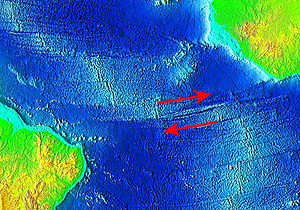|
Fracture zone Approximate surface projection on oceans of named fracture zones (orange). Also shown are relevant present plate boundaries (white) and associated features (lighter orange). Click to expand to interactive map.[1]  A fracture zone is a linear feature on the ocean floor—often hundreds, even thousands of kilometers long—resulting from the action of offset mid-ocean ridge axis segments. They are a consequence of plate tectonics. Lithospheric plates on either side of an active transform fault move in opposite directions; here, strike-slip activity occurs. Fracture zones extend past the transform faults, away from the ridge axis; are usually seismically inactive (because both plate segments are moving in the same direction), although they can display evidence of transform fault activity, primarily in the different ages of the crust on opposite sides of the zone. In actual usage, many transform faults aligned with fracture zones are often loosely referred to as "fracture zones" although technically, they are not. They can be associated with other tectonic features and may be subducted or distorted by later tectonic activity. They are usually defined with bathymetric, gravity and magnetic studies. Structure and formationMid-ocean ridges are divergent plate boundaries. As the plates on either side of an offset mid-ocean ridge move, a transform fault forms at the offset between the two ridges.[2] Fracture zones and the transform faults that form them are separate but related features. Transform faults are plate boundaries, meaning that on either side of the fault is a different plate. In contrast, outside of the ridge-ridge transform fault, the crust on both sides belongs to the same plate, and there is no relative motion along the junction.[3] The fracture zone is thus the junction between oceanic crustal regions of different ages. Because younger crust is generally higher due to increased thermal buoyancy, the fracture zone is characterized by an offset in elevation with an intervening canyon that may be topographically distinct for hundreds or thousands of kilometers on the sea floor. Geologic importance    As many areas of the ocean floor, particularly the Atlantic Ocean, are currently inactive, it can be difficult to find past plate motion. However, by observing the fracture zones, one can determine both the direction and rate of past plate motion. This is found by observing the patterns of magnetic striping on the ocean floor (a result of the reversals of Earth's magnetic field over time). By measuring the offset in the magnetic striping, one can then determine the rate of past plate motions.[4] In a similar method, one can use the relative ages of the seafloor on either side of a fracture zone to determine the rate of past plate motions. By comparing how offset similarly aged seafloor is, one can determine how quickly the plate has moved.[3] ExamplesBlanco fracture zoneThe Blanco fracture zone is a fracture zone running between the Juan de Fuca Ridge and the Gorda Ridge. The dominating feature of the fracture zone is the 150 km (93 mi) long Blanco Ridge, which is a high-angle, right-lateral strike slip fault with some component of dip-slip faulting.[5] Charlie-Gibbs fracture zoneThe Charlie-Gibbs fracture zone consists of two fracture zones in the North Atlantic that extend for over 2,000 km (1,200 mi). These fracture zones displace the Mid-Atlantic Ridge a total of 350 km (220 mi) to the west. The section of the Mid-Atlantic Ridge between the two fracture zones is seismically active.[6] The flow of major North Atlantic currents is associated with this fracture zone which hosts a diverse deep water ecosystem.[7]: 3 Heirtzler fracture zoneThe Heirtzler fracture zone was named after James Ransom Heirtzler, who first demonstrated through magnetostratigraphy that the Mid-Atlantic Ridge was spreading south of Iceland, providing the first clear evidence for plate tectonics.[8] This name was approved by the Advisory Committee on Undersea Features in 1993.[9] The area around the Heirtzler fracture zone and the Pacific–Antarctic Ridge which is a southwestern portion of the East Pacific Rise has been mapped in detail by amongst other techniques magnetostratigraphy (see picture on this page).[10] Mendocino fracture zoneThe Mendocino fracture zone extends for over 4,000 km (2,500 mi) off the coast of California and separates the Pacific plate and Gorda plate. The bathymetric depths on the north side of the fracture zone are 800 to 1,200 m (2,600 to 3,900 ft) shallower than to the south, suggesting the seafloor north of the ridge to be younger. Geologic evidence backs this up, as rocks were found to be 23 to 27 million years younger north of the ridge than to the south.[11] Romanche fracture zoneAlso known as the Romanche Trench, this fracture zone separates the North Atlantic and South Atlantic oceans. The trench reaches 7,758 m (25,453 ft) deep, is 300 km (190 mi) long, and has a width of 19 km (12 mi). The fracture zone offsets the Mid-Atlantic Ridge by more than 640 km (400 mi).[12] Sovanco fracture zoneThe Sovanco fracture zone is a dextral-slip transform fault running between the Juan de Fuca and Explorer Ridge in the North Pacific Ocean. The fracture zone is 125 km (78 mi) long and 15 km (9.3 mi) wide.[13] See alsoReferences
|

